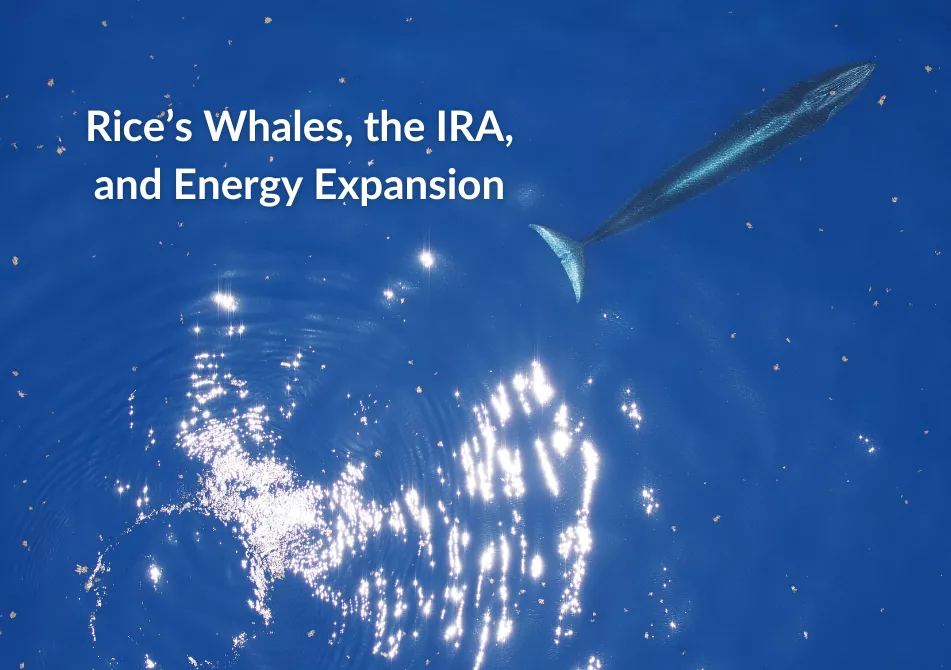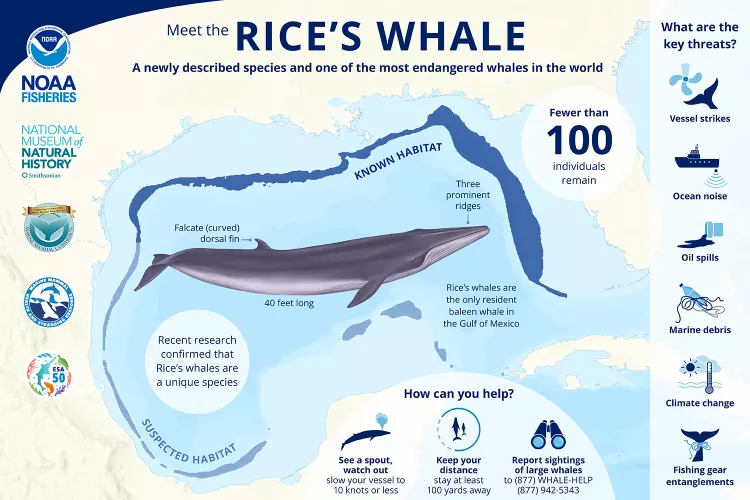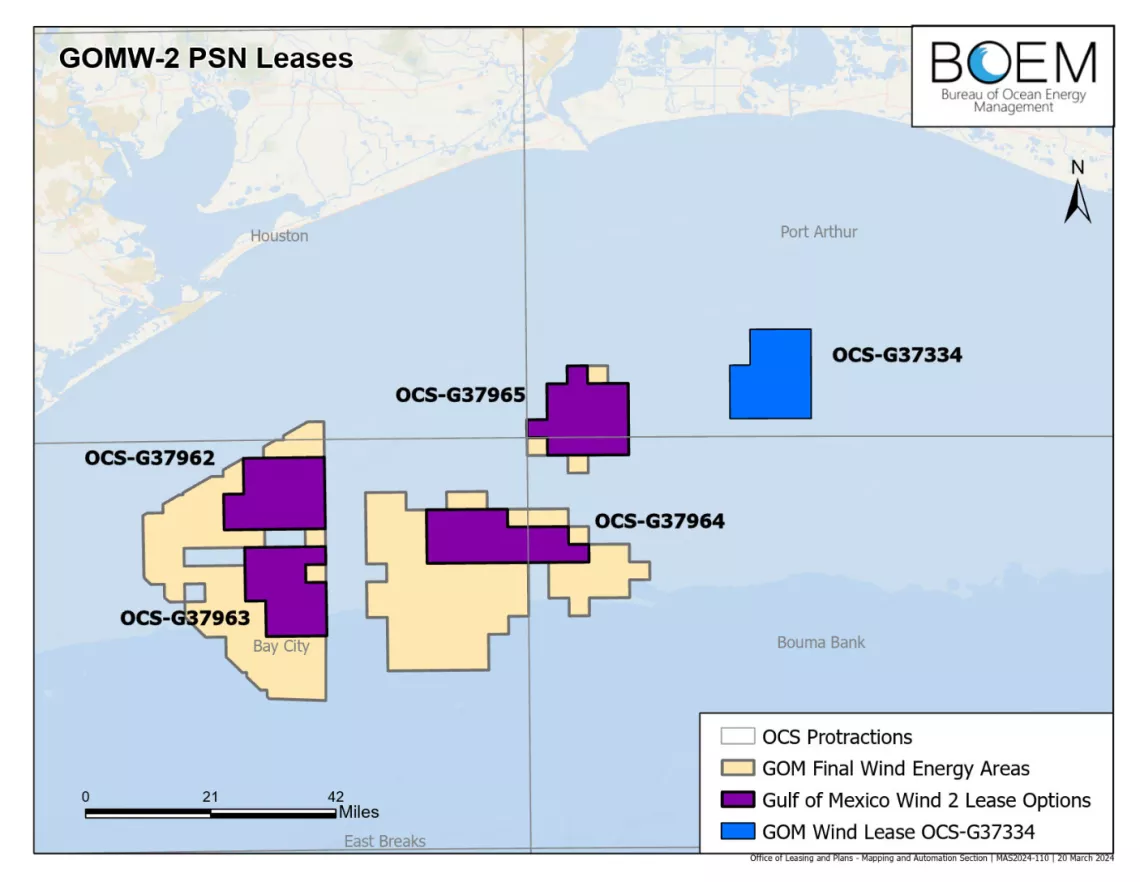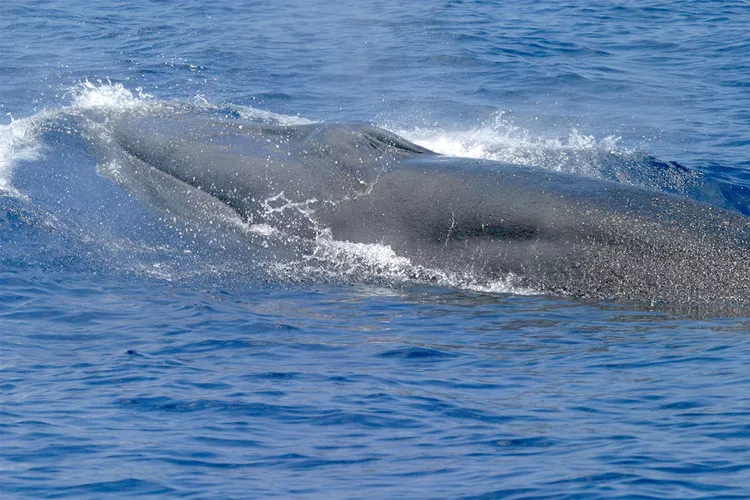
Photogrammetric image of an endangered Rice’s whale captured by a drone during a cruise aboard the NOAA Ship Gordon Gunter in the Gulf of Mexico, June 2019. Photo obtained under ESA/MMPA permit #21938. Credit: NOAA NEFSC
By Cyrus Reed
When Congress passed the Inflation Reduction Act (IRA) back in late 2022, most large “green” groups celebrated the impressive amounts of federal funding that would be going toward the development of clean energy, clean transportation, transmission, and workforce development programs that will overall lower carbon emissions and create well-paying jobs throughout the U.S., particularly in communities that have often been left behind. At the same time, there was also acknowledgement that the IRA was part of a political compromise – mainly with one Senator from West Virginia, Joe Manchin – who made sure that some polluting fossil fuel technologies were included in the provisions, leading many of the frontline communities to oppose the bill. As an organization, Sierra Club did support passage of the final legislation, but we also acknowledged many of the harmful provisions and pushed hard to have them removed.
As is often the case, there is truth in both perspectives – some programs by design are already leading to historic investments in clean energy and in frontline communities while others do continue the legacy of toxic pollution on overburdened communities.
One of these areas that shows both the promise and the peril of the IRA, and how quickly it has been politicized, is the issue of oil and gas leasing and leasing for offshore wind in the Western Gulf of Mexico off the coast of Texas and Louisiana. Suddenly rearing its beautiful, majestic head is the Rice’s whale, a relatively newfound but endangered species that has some politicians – and some oil and gas companies – frothing at the mouth. And in the midst of it are important decisions coming up on leasing for both oil and gas and offshore wind.
OK what did the IRA actually say about offshore oil and gas drilling and offshore wind in the Gulf?
The IRA was a compromise and it included a tit-for-tat requirement that prevented the Biden administration from seeking clean energy solutions like offshore wind unless it allowed further oil and gas leasing in the Gulf.

Thus, despite some delays caused by lawsuits from the Sierra Club and others to try and force a real consideration of the impact of further leasing on climate change and endangered species, in the last two years, the administration has held two large oil and gas leases, both of which will lead to billions of barrels of oil and billions of cubic feet of gas being drilled in the Gulf. Known as Lease Sales 259 and 261, the Bureau of Ocean Energy Management (BOEM) was required to hold lease sales by the end of March and September 2023, respectively, as directed in the Inflation Reduction Act of 2022.
The first, called Lease No. 259, had been on hold as the administration considered its offshore oil and gas leasing policy, but after conducting some public hearings and issuing a final supplemental Environmental Impact Statement, the lease was held on March 29, 2023. Thirty-two companies participated in the sale, and a total of $263.8 million in high bids were offered on 313 tracts. After geological, geophysical, engineering, and economic analyses, BOEM awarded a total of 299 leases on tracts covering approximately 1,599,448 acres. The accepted high bids are valued at $250,556,978.
The second – Lease Sale 261 – was held on December 20th, 2023. The lease had actually been delayed for several months due to legal action by the Sierra Club and others. However, on November 14th, 2023, an order was issued by the United States Court of Appeals to hold the lease. Sierra Club and others argued that the lease must better consider the impacts on endangered species and on climate change, but other than some further analysis of greenhouse gas impacts no additional protections for the Rice’s whale or other species were implemented. In fact, areas that may include important Rice’s whale habitat were included in the lease sale.
Lease Sale 261 offered 13,482 previously unleased blocks on 72.7 million acres in the Gulf’s Western and Central Areas. Sale 261 generated $382,168,507 in high bids for 311 tracts covering 1.7 million acres in federal waters of the Gulf of Mexico. A total of 26 companies participated in the lease sale, submitting 352 bids totaling $441,896,332. Pursuant to a ruling from the United States Court of Appeals for the Fifth Circuit, BOEM included lease blocks that were previously excluded due to potential impacts to the Rice’s whale population from oil and gas activities in the Gulf of Mexico.
In response, the Sierra Club issued a statement pointing out that while the lease sale offered was smaller than previous sales in previous administrations, it was still damaging to the planet, could impact whale species, and perpetuated oil and gas leasing in public waters.
To put it all in perspective, oil and gas companies have been drilling in the Western Gulf for decades, abetted by a federal government open to leasing those lands and enabling many many spills, air pollution, and harmful impacts on the environment and coastal communities. Think “BP oil spill.” A map found here puts in perspective just how much of the Gulf has been leased, often at cut-rate prices. Lease Sale 261 continued this tradition, even though it was smaller than previous sales.
Ok, so more oil and gas leasing… but we will get some clean energy out of the deal, right?
Well, maybe a little, and a little would be a start. On October 31, 2022, BOEM announced it had finalized two Wind Energy Areas (WEAs) in the Gulf of Mexico. The first was located approximately 24 nautical miles (nm) off the coast of Galveston, TX. The second final WEA is located approximately 56 nm off the coast of Lake Charles, LA. But while several companies announced they would bid, in the end only one made a successful bid for the area off the coast of Louisiana.
At $5.6 million, RWE Offshore US Gulf, LLC was the winner of the first-ever offshore wind energy auction for the Gulf of Mexico region. The Lake Charles Lease Area has the potential to generate approximately 1.24 gigawatts of offshore wind energy capacity and power nearly 435,400 homes with clean, renewable energy. Apparently that company has an existing agreement with the large private utility Entergy and would provide electricity to customers largely in the Louisiana market as part of that company’s pledge to reduce carbon emissions from its electricity production.
One reason companies wanting to provide electricity in Texas might have decided not to bid on the wind leases is political opposition. Several legislative and other elected statewide officials in Texas actively oppose offshore wind, including Railroad Commissioner Wayne Christian, Republican State Senator Mayes Middleton, and General Land Office Commissioner Dawn Buckingham. All have made statements indicating concern or outright opposition to offshore wind development in Texas due to their interest in oil and gas development. Their statements are fanciful, arguing against the jobs, economic development, and electricity that large-scale wind turbines would bring, claiming they would impact shipping lanes and… oil and gas development.
It’s strange they would equate offshore wind with a loss in economic opportunity given the many companies located in Texas that would be suppliers to the offshore wind development, including a company outside Brownsville that is manufacturing the first offshore vessel needed to carry massive wind turbines out to the open sea. Dominion Energy’s wind turbine installation vessel Charybdis is under construction at the Seatrium AmFELS shipyard. The massive ship would be the first U.S.-built offshore wind installation vessel. The Charybdis is using more than 14,000 tons of domestic steel, mostly sourced from Alabama, North Carolina, and West Virginia, hiring hundreds of workers in the process.
These same officials have even cited endangered and threatened species like the Rice’s whale, which, given their antipathy to protection of other endangered species in the oil patch onland, seems almost comical… or at the very least hypocritical. These same officials have advocated for much greater amounts of oil and gas leasing despite its known impact on such species. The Sierra Club position is clear – the whale must be protected through site selection of wind turbines during construction, but more importantly by restricting the speed of ocean-going vessels involved in oil and gas drilling, supplying wind turbines, and other commercial activities. In addition, the rights of commercial fishermen must be balanced with oil and gas and offshore wind development. Done correctly, offshore wind facilities can actually increase fishing opportunities, but if done incorrectly they can negatively impact them.
Just last month the Biden administration and Bureau of Ocean Energy Management (BOEM) announced they would be holding a second lease sale in the Gulf for offshore wind. The proposed lease sale announced March 20th includes four areas offshore Louisiana and Texas, totaling 410,060 acres, with the potential to power 1.2 million homes with wind energy.

Image via the Bureau of Ocean Energy Management: https://www.boem.gov/renewable-energy/state-activities/gulf-mexico-activities
First, however, they are opening up public comments on the proposed areas, any environmental stipulations, and other matters. The Proposed Sale Notice published in the Federal Register on March 21, 2024, initiated a 60-day public comment period ending on May 20, 2024. To see the documents and make comments you can go here. Sierra Club will be working with allies like the National Wildlife Federation on comments before the deadline. If and when BOEM decides to proceed with the auction, the next step would be publication of a Final Sale Notice, likely this summer.
Ok so what is happening with the Rice’s whale?
It’s a very, very rare endangered species and there are less than 100 of these whales left – maybe as few as 50. Related but distinct from the right whale found further north, a single Rice's whale sighting was confirmed in the western Gulf of Mexico off the coast of Texas in 2017. New science led by National Oceanic and Atmospheric Administration (NOAA) Fisheries provides more evidence that these whales may be more prevalent in the western Gulf of Mexico than previously thought.
Rice’s whales can grow up to 40 feet long and are one of the only types of baleen whales that prefer warmer, tropical waters. They’re found only in the Gulf of Mexico and spend the majority of their time in shallow water, which puts them at risk from vessel strikes and entanglements. More boats and more development in the Gulf are problematic for Rice’s whales and other marine life.
The Biden administration has been pursuing some efforts to better protect whale species, including proposing new limits on vessel speed to protect the right whale further north in the Atlantic and proposing critical habitat for the Rice’s whale. The right whale is also endangered, and recently a number of whales have washed up dead on beaches in the northeast, causing some to blame wind development. However, NOAA Fisheries states, “There are no known links between large whale deaths and ongoing offshore wind activities.” By far the largest causes of untimely whale deaths seem to be vessel collisions and getting caught in fishing nets.
In 2023, the National Marine Fisheries Service proposed to designate a huge swath of waters in the Gulf of Mexico – approximately 28,270 square miles – as expanded critical habitat for the Rice’s whale. As expected, Texas’s oil and gas producers and state agencies like the Railroad Commission came out against the proposal, arguing that “the zealous proposal may lead to major limitations when transporting oil and gas products, which in turn would have an alarming and negative effect on the economy of Texas.”
Thus far no final decision has been made on the critical habitat designation, but a decision could come as soon as June. Even as critical habitat decisions are considered, oil and gas leases are moving forward, as well as a recent decision to allow construction of a huge oil export terminal called SPOT (Sea Port Oil Terminal). Any energy development of the Gulf should be considered in concert with protections for mammals, fish, and migratory birds, but offshore wind is not the problem as it does not even exist yet. If we are ever to transition away from oil and gas, we must also build out clean energy resources like offshore wind development and do so in a way that prioritizes local communities and workforce development but also protects habitats.
The Lone Star Chapter will be working with the national Sierra Club organization and partners as we develop comments and actions to assure our clean energy future, which hopefully will include offshore wind off the coast of Texas.

Rice's Whale. Credit: NOAA Fisheries